Strawberries
J Rooting of Strawberry Plants
I have had occasion in my travels over the past two weeks to find a good quantity of what is depicted in the two photos below: J-rooting of strawberry plants.
J-rooting of strawberry plants occurs when the root is too long for the planting hole (Photo 1 below shows how big a healthy transplant can be - lots of those this year by the way) which has been made for it and subsequently the root tips end up pointing upwards rather than down. All too frequently, these upward pointing root tips end up being outside of the hole in the open air, as depicted in Photo 2 below.
It is not difficult to understand why J rooting is not beneficial to the plant. Root extension in plants takes place from the root tips, and having them exposed to the open air, drying out and dying does nothing to help this process along and represents a setback to the establishing plant. To be blunt, it’s a bad practice to be planting this way and shows a costly lack of attention to detail.
Transplanting is hard, back breaking work and it’s not too difficult to empathize and understand how J rooting can happen all too easily. Growers can help their planting crews along and get the roots straight down by several ways. Already having a deep hole or slot to be placing the transplant into helps a lot. Additionally, growers can ask that nurseries trim the roots to reduce the length of root of the transplant to better the odds of everything going straight down. In field quality control on the day of planting by the person in charge also goes a long way in making sure J rooting doesn’t become a pattern in for one individual or the crew.
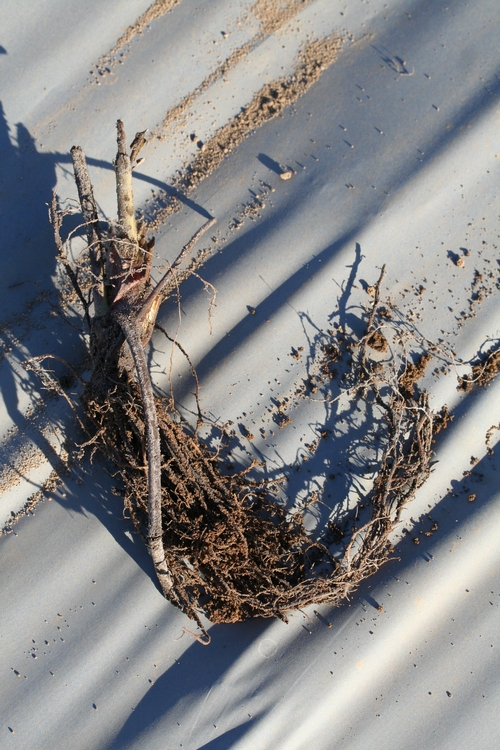
A healthy transplant showing the extent of the roots.
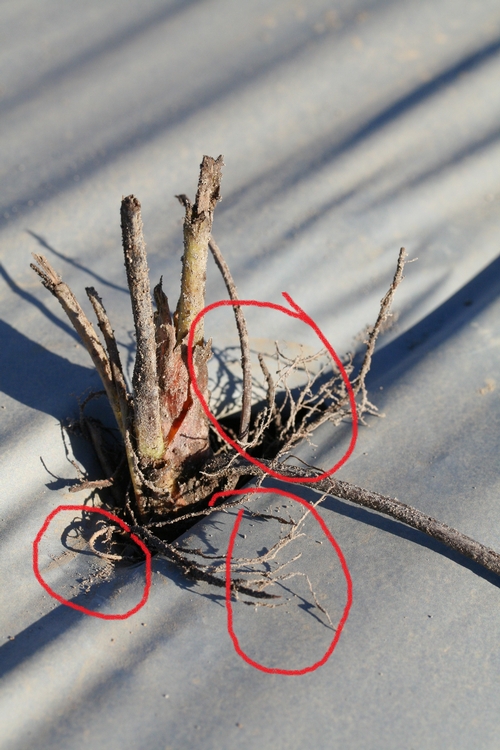
J rooted strawberry transplant showing roots exposed to the open air from improper placement in the hole.
Will the Breakup of the Potash Cartel from the former Soviet Union Affect Berry Cost of Production?
This past July the Russian potash producer OAO Uralkali threw the global potash market for a loop by halting its long running cooperation in what was essentially a cartel with the Belorusian owned producer Belaruskali, enabling it to now produce potash flat out and very likely gain a lot of market share. Not incidentally this move has landed the CEO of Uralkali in house arrest for abuse of power and embezzlement. Whatever the case may be, this decision has turned an oligopoly for potassium supply into a much freer market, and has consequently sent potash prices plummeting, crushing the shares of several listed American potash distributors in the process (Graphic 1 and 2 below).
In numbers, Uralkali plans on increasing production of potash from 10.5 million pounds this year to 13 million next year, out of a total global market of some 50 million pounds per year. According to Bloomberg, this separation of the two companies should bring the price of potash from above $400 a ton before July, 2013 to approximately $300 a ton.
What does this mean for local berry producers? Probably not a lot. First, potassium is a tiny proportion of berry cost of production of the already small cost of fertility at under 2% of the total. Second, if my experience and lots of soil and tissue samples serve me right, there is not much necessity for adding much more potassium to many of our soils! After decades of potassium fertilizer additions, this non-mobile nutrient has built up to astonishing levels in many of our fields (adequacy of K in soil in usually thought of being 200-300 ppm and in leaf tissue above 1.3% during the harvest season), meaning in most cases that required additions are quite small.
Contrast this with the case of the Central Valley for producers of heavy potassium feeding crops such as almonds for example. Scanning the Cost of Production studies for almonds, we find that annual potassium fertilizer use resides north of 5% of total costs of production, not to mention that the “potassium gravy train is coming to an end” for many other crops of the San Joaquin Valley in the words of Dr. Tim Hartz of UC Davis, with the decades long draw down of what were formerly potassium rich soils. Might be a good time for these growers to start loading that potassium back up again while prices are down.
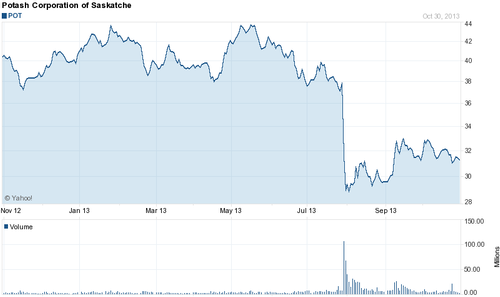
Shares of Potash Corporation pounded in late July after the break up of the Belorussian potash cartel - what does it mean for local berry producers?
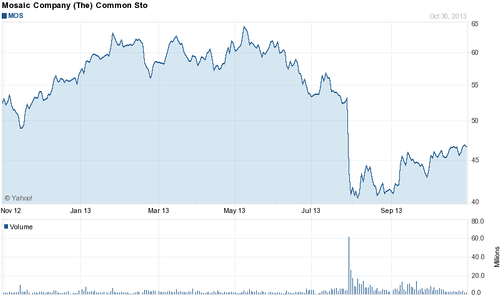
Shares of the Mosaic Company down heavily in late July after the break up of the Belorussian potash cartel - maybe a good time to bring K deficient soils back to par.
Review of Chill for the UC Day Neutral Strawberry Varieties Albion, San Andreas and Monterey
I had a conversation quite recently with Doug Shaw, UC plant breeder, concerning the concept of chill in the day neutral varieties and the desire of some Central Coast growers to reduce the recommended amounts significantly, even all the way down to zero days of chill:
In the way of review, please recall that chill requirement in strawberry in California is made up of two essential parts. One part is what the plant accumulates in the field before being harvested, and the other is accumulation of chill after harvest and the plant is in storage. There is a big difference between the two and one does not supplant the other. In-field chill takes place when the plant is still in the soil, out in the open and still has all its leaves. Supplemental chill takes place after harvest of the plant and occurs in a constant near freezing temperature, in the dark and the plant has none to very few leaves left (Figure 1 below).
Accumulation of chill, especially supplemental chill, in the strawberry transplant makes it stronger and better able to survive the stress of plant harvest, transplant and the growing season beyond.
As some of the chill sensitivity has been bred out of the modern UC day neutral varieties such as Albion, Monterey and especially San Andreas, it is indeed possible to grow these varieties with less than the recommended amounts (10-18 days) of supplemental chill. However, those who choose to reduce chill below these amounts should recognize the amount of risk they are taking and that this is not an exercise for those still using training wheels. Should growing conditions take a turn for the worse, these underchilled plants do not have the vigor to help them pull through and will suffer more than those adequately chilled. Moreover, while UC day neutral strawberry plants chilled significantly less than the recommended 10-18 days can produce fruit earlier than others (probably owing to the earlier planting date), these plants quite likely will not perform optimally in terms of overall yield and quality along with showing a tendency to produce smaller fruit later on in the season.
The only case where one would want to go short on supplemental chilling time would be if the plant harvest was so late that a minimum chill time of 10 days would result in a planting date so late that it would compromise plant growth and establishment.
Other than that, it is still recommended to give the UC day neutral varieties 10-18 days of supplemental chill.
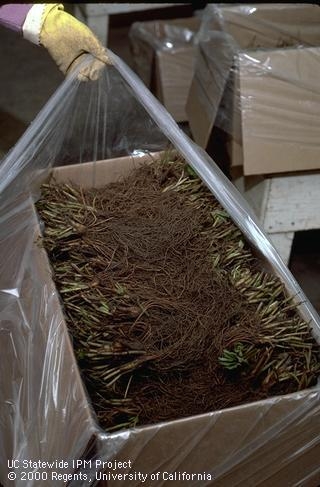
Trimmed transplants being packaged in box with polyethylene lining, ready for placement into the cooler for supplemental chilling.
Clarification on the Use of Chateau (flumioxazin) prior to Strawberry Transplanting
A response to the question posed to us concerning how soon one should be applying water to Chateau (flumioxazin) sprayed in the furrows for weed control in strawberry. The label says that this herbicide can be applied at a minimum of 30 days before transplant of strawberries, but it doesn’t seem to specify how soon to apply the water after application.
Probably the sooner you apply water to furrows the better, but in a study run by Oleg in Ventura County, Chateau was applied to furrows about a month before sprinklers were turned on and the herbicide was effective against several broadleaf weed species, including wind-dispersed weed seed that landed in furrows after application.
Chateau does not degrade and just remains on soil surface, provided furrows stay dry during that time. If the furrows get wetted enough to germinate weeds the herbicide will be sufficiently activated as well.
The residual efficacy of Chateau is diminished over time, but you can reapply it to furrows if needed – there is no co-distillation, so as long as there is no drift, strawberry plants should be safe. You can extend the control by reapplying it with shielded sprayer in-season as long as the strawberry plants do not have flowers and fruit (which is soon in Southern California but quite a bit later here in Watsonville and Salinas) and you do not intentionally overspray the beds (first photo below) .
Also, thinking about traffic going through the field after application, specifically the wheels of tractors moving through the furrows, it does create some breaks in the barrier that the initial application of Chateau has formed. It might be interesting to do a little experiment with different levels of disturbance post-application to see how much efficacy really is affected. However, remember that Chateau can be reapplied later on in December and January in the furrows in order to get better control since it will be catching multiple flushes and cohorts of weeds from both the seed bank and wind dispersal.
UC IPM guidelines for Chateau in strawberry are available at:
www.ipm.ucdavis.edu/PMG/r734700411.html
The use of flumioxazin (Chateau) is extensively written about in this article. Before this or any other product, check with your local Agricultural Commissioner's Office and consult product labels for current status of product registration, restrictions, and use information.
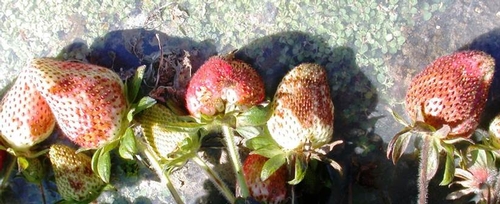
Damage to strawberry fruit by Chateau sprayed directly on top - don't do this! Photo courtesy Oleg Daugovish - UCCE.
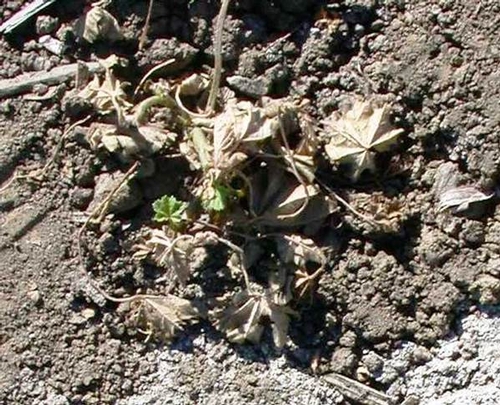
Effect on mallow sprayed with Chateau. Photo courtesy Oleg Daugovish - UCCE.
Year One of a Test of Biological Fungicides in Strawberries.
This is simply a summary of one year of biological fungicide work in strawberries in 2012-2013 and should not be understood as a recommendation to use any of these products. This investigation is will continue into 2013-2014 and will serve to confirm and adjust the work here.
Introduction: A number of biological fungicides registered for use in strawberries have not been thoroughly tested through empirical studies to give guidance to growers on their efficacy and use.
Materials and Methods:
Table 1 below is an outline of materials tested in 2012-2013.
The field involved in the study was organically farmed and had a tested infestation of Verticillium at the average level of 25 microsclerotia per treatment replicate. Grower standard was managed as per grower practice, that is to say normal irrigation, fertility and pest management practices were applied. This grower standard did not include any sort of biological fungicide either by dip or injection through the drip tape during the season.
Plot was replicated three times and each replicate consisted of at one bed of 180 feet in length.
Application of the materials took place as indicated in the table below:
Table 1. List of treatments.
|
Test Material |
Application/ Use |
|
Dazitol |
6.25 gal/A applied 3-5 days prior to planting |
|
Biotam + Serenade Soil |
5 lbs/A pre-plant application 3-5 days prior to planting followed by Serenade Soil @ 4 qt/A (10 days after planting, and then Serenade Soil @ 2 qt /A applied monthly after planting. Second application of Biotam 5 lbs/A and Serenade Soil @ 4 qt/A in February. |
|
Serenade Soil |
Serenade Soil @ 4 qt/A (10 days after planting, and then Serenade Soil @ 2 qt /A applied monthly after planting. |
|
Serenade Soil |
Serenade Soil @ 4 qt/A (10 days after planting, and then Serenade Soil @ 4 qt /A applied every 60 days after planting. |
|
Actinovate Rate 1 |
(1) 3 oz per 100 gal root dip at planting. (2) followed by 6 oz/A pre-plant in drip tape (3) followed by 3 oz/A every 30 days in drip tape
|
|
Actinovate Rate 2 |
(1) 3 oz per 100 gal root dip at planting. (2) followed by 6 oz/A pre-plant in drip tape (3) followed by 6 oz/A every 30 days in drip tape
|
|
SoilGuard |
Apply at planting as root dip or planting furrow drench at 5 lb/ A and again through drip tape every 4-6 weeks through harvest. |
|
Double Nickel 55 |
Apply at planting at 1 qt /A (1/2 lb/A powder) as root dip or planting furrow drench and again through drip tape every 4-6 weeks through harvest. |
|
Terra Clean 5.0 |
(1) 128 fl oz/100 gal drench (2) 2 gal/A drip applied at planting (3) 1 gal/A drip applied 10 days post plant and 28 days post plant (4) 1 gal/A drip applied 60, 90 and 120 days post plant |
|
Terra Clean 5.0 + Serenade Soil |
(1) 128 fl oz Terra Clean /100 gal drench + Serenade Soil @ 6 qt/ A soil drench (2) 2 gal/A Terra Clean drip applied at planting followed by SS @ 3 qt /A (3) 1 gal/A Terra Clean + 3 qt /A Serenade Soil drip applied 10 days post plant and 28 days post plant (4) 1 gal/A Terra Clean + Serenade Soil @ 3 qt/ A drip applied 60, 90 and 120 days post plant |
|
Tainio |
(1) Spectrum @ 50 g / A + Pepzyme C @ 12.5 oz/A 2- 3 days preplant (2) Biogenesis @ 1 lb/A+ Pepzyme C @ 12.5 oz/A as plant dip (3) Pepzyme C monthly through drip tape (4) Micro 5000 @ 2.66 oz/A at 2 leaf stage foliar |
Plant dips were made by suspending the requested rate of fungicide in approximately twenty gallons of water and submerging and soaking about a half a box of strawberry transplants (about 500 plants) thoroughly and then distributing to planting crews for transplant. Note that in the case of the two Actinovate treatments, plants were held for one night to prior to transplant, ostensibly to establish the organism on the plant roots.
Drip applications were made with a portable pump injecting each fungicide. Each application normally was preceded by filling the drip tape with clear water, injecting the mix and then further pumping in clear water to make sure the fungicide had moved well out of the drip tape.
Application dates:
Preplant application – 11/3/2012
Dazitol
Terra Clean 5.0
Terraclean 5.0 + Serenade Soil
Tainio Spectrum + Pepzyme C
Biotam
Root dip + one overnight hold – 11/7/2012 (planted November 8)
Actinovate rate 1
Actinovate rate 2
Root dip and immediate planting – 11/8/2012
Double Nickel 55
Soilguard
Biogenesis + Pepzyme C
10 days post – plant – 11/20/2012
Serenade 4 qt
Serenade 2 qt
Monthly applications (12/11/2012, 1/16/2013, 2/26/2013, 3/27/2013, 4/30/2013, and 6/13/2013)
Terra Clean 5.0
Terraclean 5.0 + Serenade Soil
Tainio Spectrum + Pepzyme C
Serenade 4 qt
Serendade 2 qt
Actinovate rate 1
Actinovate rate 2
Double Nickel 55
Biotam applied 2/26/2013; Serenade 4 qt per acre applied other dates in treatment
Soilguard
Several dying plants from different areas of the test plots were sampled in July to confirm that Verticillium was the cause of plant death.
As a gauge of plant vigor from each treatment, strawberry plant diameters were measured February 13, and April 13. Measurements were in centimeters and from twenty plants in each plot.
With the beginning of fruit ripening, fruit harvest was done weekly in each treatment replicate. On each pick date, fruit from each plot was weighed and counted.
Results:
|
|
Plant D cm 2/13/2013 |
Plant D cm 4/13/2013 |
Yield to 5/14/2013 |
April Total Yield g/plot |
|
Actinovate r1 |
14.05a |
16.25a |
3894.00a |
2175.00ab |
|
Actinovate r2 |
13.70ab |
16.42a |
3818.33a |
2428.00a |
|
Biotam |
11.47b |
15.77a |
2176.67b |
1377.00b |
|
Dazitol |
11.70b |
17.70a |
2505.67ab |
1568.00ab |
|
Double Nickel 55 |
12.65ab |
15.92a |
3084.00ab |
1637.00ab |
|
Serenade 4 qt +2 qt |
11.57b |
16.65a |
2853.00ab |
1471.67b |
|
Serenade 4 qt +4 qt |
12.42ab |
16.02a |
2621.00ab |
1459.67b |
|
Soilguard |
11.85b |
16.78a |
2993.33ab |
1652.33ab |
|
Tainio |
12.93ab |
16.95a |
3454.00ab |
2075.33ab |
|
Terraclean |
11.50b |
16.78a |
2284.00b |
1406.67b |
|
Terraclean + Serenade |
12.47ab |
17.11a |
2656.33ab |
1559.67ab |
|
Untreated grower standard |
11.70b |
17.90a |
2145.00b |
1189.00b |
Means followed by same letter do not significantly differ (P=.05, Student-Newman-Keuls)
|
|
May Total Yield g/plot |
June Total Yield g/plot |
July Total Yield g/plot |
Aug Total Yield g/plot |
Total Yield g/plot |
|
Actinovate r1 |
3741.67a |
2791.00a |
1902.33a |
140.64a |
16820.67a |
|
Actinovate r2 |
3069.67a |
3237.67a |
2812.33a |
149.35a |
17201.34a |
|
Biotam |
2254.00a |
3251.33a |
3402.00a |
503.14a |
14468.33a |
|
Dazitol |
2514.67a |
3075.33a |
3049.33a |
269.16a |
14625.00a |
|
Double Nickel 55 |
3038.67a |
2837.67a |
2573.67a |
203.64a |
15052.67a |
|
Serenade 4 qt +2 qt |
3244.67a |
3287.00a |
3623.67a |
371.49a |
16887.67a |
|
Serenade 4 qt +4 qt |
2959.67a |
3617.67a |
3236.33a |
362.02a |
16157.00a |
|
Soilguard |
3212.33a |
3331.67a |
2887.00a |
359.45a |
16352.33a |
|
Tainio |
3409.00a |
3687.33a |
3190.33a |
170.27a |
18145.00a |
|
Terraclean |
2496.67a |
2997.00a |
2750.00a |
125.01a |
13681.33a |
|
Terraclean + Serenade |
2544.00a |
2810.00a |
2230.00a |
191.78a |
13454.33a |
|
Untreated grower standard |
2812.00a |
4019.33a |
3800.00a |
306.15a |
16150.33a |
Means followed by same letter do not significantly differ (P=.05, Student-Newman-Keuls)
Plant diameters measured on February 13, 2013, were significantly larger in the low rate of Actinovate than the other treatments with the exception of the high rate of Actinovate, Tainio and Double Nickel 55.
Both rates of Actinovate realized higher fruit yield than all other treatments except for the Dazitol, in cumulative fruit yield, which included six weekly harvests, up to May 14, 2013. No further differences were realized between May and August.
As noted above, this field has a very high infestation of Verticillium and all plots began to experience pronounced plant dieback in June, with some 60-80% remaining alive or declining and by end of July, nearly all plants in all replicate plots had died. There was a trend for plants which had produced larger amounts of fruit in April and May to experience lesser fruit production lesser vigor and earlier dieback as the season progressed.
Conclusion
The results of this trial are encouraging. In the early part of the season up through the middle of May, several treatments had significantly higher amounts of fruits harvested than the grower standard. Nonetheless, none of the treatments provided sufficient protection to the plants to prevent an almost complete die out of the plants by August, effectively ending the season.

